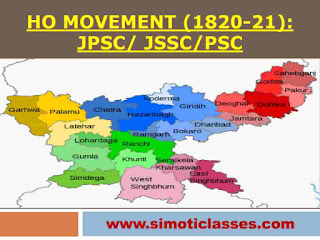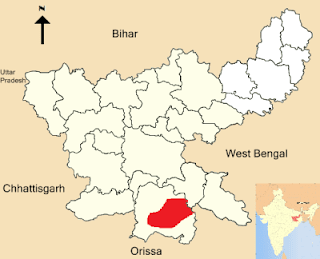Mughal Era Jharkhand: Jharkhand History
Mughal Administrator: The number of small and big states in Jharkhand increased further during the Mughal period. The biggest change was that after defeating the Raxales, the Chero established a new kingdom in Palamu. Yet Jharkhand was spared from Muslim encroachment. Ultimately, Sher Khan paved the way for the entry of Muslims into it. Sher Shah had got the right over Rohtasgarh in 1538 AD. But when he lived in a military campaign or was in trouble, the Chero people would come out of the jungles of Jharkhand to persecute the peasants and plunder with travelers on the way to Bengal, or sometimes even in the army camps of Sher Shah screaming. Therefore, Sher Shah needed to suppress them. In the course of Sher Shah's struggle with the Mughals, this area was his shelter. So he was understanding the importance of this area.
Babur-Humayun Era Jharkhand:
During the reign of Mughal emperors Babur (1526-30 AD) and Humayun (1530-40 AD), Jharkhand was out of their sphere of influence, so the regional kings of Jharkhand continued to rule without any external interference. Since Babur had established the Mughal dynasty by overthrowing the Afghans while living in Bihar-Bengal were trying to gather power again and compete with the Mughals. Thus during the reign of Babur and Humayun, Jharkhand became a haven for the anti-Mughal Afghans. Humayun had entered Bhurkunda (Hazaribagh) on one occasion during the Mughal-Afghan conflict. Humayun's greatest enemy Sher Shah used this area several times in the Mughal-Afghan conflict (1530-40 AD).
Akbar's reign:
In the year 303 (1585 AD) of the reign of the Mughal Emperor Akbar, the first military conflict of the Mughals with Jharkhand started. The only thing that happened in the preceding 45 years was that under pressure from the Mughals, the Afghan rebels would take shelter in the forests here and reach Jharkhand in pursuit of the Mughals. During the reign of Akbar, there were three (3) major ruling dynasties in Jharkhand:
During Akbar's time, the Mughal paid attention to this region for political, strategic, and economic reasons. With the possession of this area, the problem of elephants was removed for the Mughal army. Probably diamonds were also obtained from the Sankh river in this region. In 1585 AD, the Mughal army invaded this region. At this time the king of Kokrah was Madhukaran Shah. It seems that he was also taken captive and presented in the royal court, where because of his humble nature, the emperor again sent him to Kokrah. Thus by end of the 16th century, the neutrality of Kokrah had been broken and the region had come under the control of Mughals and had to pay annual taxes to them. The biggest thing was that the king here had become a trusted subordinate of the Mughals, as is evident from the help given by him to the Mughals during the Orissa campaign. Like Kokrah, the Singh dynasty kings of Singhbhum also became accomplices of the Mughals. By 1589 AD, under the leadership of Man Singh, Chero was also defeated and made a part of the empire.

Jahangir's reign:
During the reign of Jahangir, a completely new era began in the history of Mughal-Jharkhand relations. Especially in the context of Mughal-Nagvanshi and Mughal-Chero. Jahangir was also aware of the subject of diamonds found in Jharkhand. He has mentioned this in his autobiography Tajuk-e-Jahangir.
During the time of Jahangir, the rule of Kokrah was in hands of Durjan Sal. He also stopped paying annual taxes to the Mughal court. Therefore, disciplinary action was necessary against him. In 1615, Ibrahim Khan attacked Kokrah and presented the Durjan Sal as a prisoner to the royal court. From there he was sent to the Gwalior Fort after being sentenced to 12 years of imprisonment. Along with the Durjan Sal, some of his family members and kings were also prisoners. After this victory, Ibrahim Khan presented some diamonds and elephants to the royal court. Jahangir was deeply interested in the diamonds that could be obtained from this region. It is said that once a purple-colored diamond was found in this area. The emperor wanted complete information about the purity of the diamond. He did not know that Durjan Sal is a very good connoisseur of diamonds. This quality of Durjan Sal became the means of liberation from his prisoner life. Durjan Sal, at the behest of the emperor, checked the purity of the diamond and told it to be pure. The emperor was pleased with him and returned him to his kingdom. Permission was given to the wicked that if he had any demand, he could put it before the emperor. He made two (2) demands;
- Rajagan and his family members who were imprisoned in Gwalior Fort should be freed.
The emperor accepted both the above demands. Durjan Sal also agreed to pay 6,000 annual taxes and the Patta of his kingdom was given to him by the emperor.
In the time of Jahangir, there is a mention of the rule of two Chero kings in Palamu. But they are not mentioned in any Persian source other than the Chero Geneology of Jahangir. At the time of Jahangir, the Bishnupur of Manbhum was occupied by the Mughals. According to Baharistan-e-Gawi, the Subedar Islam Khan of Bengal attacked Veer Hammir, the zamindar of Panchet with the help of Subedar Afzal Khan of Bihar and zamindars under him. Without resistance, he surrendered to the commander of the invading army, Sheikh Kalam. There is a lack of specific information about other states during the period of Jahangir.
Shah Jahan's reign:
By the beginning of the Shah Jahan's reign, the Mughals were fully acquainted with Chotanagpur. They were also now taking a keen interest in the internal matter of this region and were making every effort to establish their dominance over the residents here. Even now the Mughals had a deep connection with only two parts of this region- Kokrah and Palamu.
In the first phase of Shah Jahan's reign, the ruler of this place was Durjan Sal. Durjan Sal ruled Kokrah for about 13 years after being freed from captivity. On his return here, he made Doisa a more strategically secure place in place of his capital Khukhra and it was decorated with many beautiful buildings. Surrounded by hills on three sides and the South Koel River on one side, the Doisa was often formidable to the enemies. There is a clear influence of Mughal architecture in the construction of the buildings established in Doisa, in which the palace of Durjan Sal, Navratgarh, or Navratnagarh is most important. It was five-storeyed but only three stories remain. After the death of Durjan Sal, Raghunath Shah probably became the ruler, and even during his period, the Mughal Nagvanshi relations remained cordial. By the end of Shah Jahan's reign, the seclusion of Kokrah had come to an end and it was now associated with the life of the people of North India. The Nagvanshi rulers were now adopting cultured administrative and architectural traditions from the border states. In this way, new concepts of power and culture developed in the forest zone.
Although even during the time of Shah Jahan, the reason for the interest of the Mughals in this area was diamond. During the reign of Shah Jahan, the Chero and Mughal relations of Palamu became more visible. In fact from this time of history of Palamu seems orderly and authentic. Probably at this time also the Chero rulers remained under the control of the Mughal rulers for a few days. Pratap Rai was the ruler of Chero during the reign of Shah Jahan. Shah Jahan appointed it a Hazari Mansabdar. The kings of the Singh dynasty of Singhbhum had close contacts with Mughals. It was during Shah Jahan's time that he agreed to pay regular annual taxes to the Mughals. There is a lack of clear information on the relations of Shah Jahan with the Manbhum (present-day Singhbhum, Dhanbad, and Hazaribagh) region.
Aurangzeb's reign:
During the reign of Aurangzeb, Jharkhand was also a victim of his imperialist mentality like other parts of India. During his time he established closer relations with the region. Also, areas like Manbhum and Singhbhum, which were almost untouched till then, were now forced to pay annual taxes. During the reign of Aurangzeb, Raghunath Shah, the Nagvanshi king of Korah, ruled for the most part. He was a man of extreme religious and charitable nature. His religious teacher was Harinath. It is said that on one occasion Raghunath donated his entire kingdom to Harinath. When Guru Harinath refused to accept such a huge donation, Raghunath declared that he was Harinath's slave and he (Raghunath) too the name of Guru. The word 'Nath' was added to his name. All subsequent Nagavanshi kings began to include the words 'Shah' and 'Nath' in their names (the first given by the Mughal emperor Akbar and the second given by Guru Harinath). Raghunath decorated his capital Doisa with many buildings and public utilities and also got many temples built here. Jagannath Temple is the most notable among these temples. Two inscriptions engraved on the wall of this temple show that it was built in 1682 AD during the reign of Raghunath Shah. Raghunath Shah built the 'Madan Mohan Temple' at a place called Boreya. The 'Ram Sita Mandir' was built in Chutiya by Hari Brahmachari. During the reign of Raghunath Shah, it appears from architectural works that the kingdom of Kokrah was internally prosperous. There was only one invasion of the Mughals during his period. Chero (Palamu) ruler Medini Rai attacked Kokrah and plundered the capital. Apart from the property looted from here, there was also a huge stone gate, which was installed by Medini Rai in the 'New Fort' of Palamu, which is still famous as 'Nagpur-Darwaja'.
Ram Shah became the ruler after the death of Raghunath Shah. Even at this time, the Mughal-Nagvanshi relations were cordial.
In the year of Aurangzeb's rule, the Chero king of Palamu was Medini Rai. He ruled from 1658 AD to 1674 AD. Perhaps initially he accepted Mughal authority, but he took full advantage of the succession battle of Shah Jahan's sons. The Chero had returned to their traditional anti-Mughal policy and started plundering and attacking the Mughal territories because of their safe haven. In fact, this free-loving caste did not accept even the nominal suzerainty of the Mughals. He not only stopped paying taxes to the Mughals' territories. This was the situation for an imperialist ruler like Aurangzeb. Aurangzeb ordered Dawood Khan, the Subedar of Bihar, to attack Palamu and collect taxes from the Chero king. He also ordered many jagirdars and faujdars of Bihar to help in this campaign of Dawood. As a result, a long military campaign started against the Chero ruler of Palamu on 23 April 1660 which lasted till December 1660. Ultimately the Chero was defeated by Medini Rai fled. The Palamu conquest was an important milestone in Dawood's military life. In this campaign, he displayed tactical skill, quick decision power, and leadership. In this memory of the Palamu victory, Dawood built a mosque in Palamu's Purana Quila in 1662 AD. While returning from there, Dawood Khan took the 'Singh Darwaza' of Palamu Fort with him and got it installed in his fort at Dawoodnagar.
After the Palamu conquest, Mankali Khan was appointed as Faujdar there, which lasted till 1666 AD. After the transfer of Mankali Khan, the administration there came into the hands of the Subedar of Bihar. After being defeated by Dawood, Medini Rai fled to Sarguja and returned to Palamu again after the departure of Mankali Khan and took control of his lost kingdom. Medini Rai has been called the 'Nyasi Raja'. He soon brought Palamu out of poverty and brought him to the pinnacle of prosperity. It seems that keeping in mind the improved condition of Palamu under him, the Mughals allowed Palamu to remain under him. Even today, Palamu people remember Medini Rai's reign as the 'Golden age of Chero rule'. Even after Medini Rai was restored to the throne of Palamu, Aurangzeb did not stop taking interest in this area and here the Mughals remained nominally sovereign.
Aurangzeb does not seem to have had any special influence on the territories included in the present Hazaribagh, Singhbhum, and Manbhum districts. At that time there were five major kingdoms in the Hazaribagh region. During the time of Aurangzeb, Dhanbad and Purulia districts remained largely outside the Mughal influence. These were only two areas in the whole of Chotanagpur, which were completely spared from Muslim invasions. At the time of Aurangzeb sitting on the throne, the Panchet kingdom regularly paid taxes to the Mughals. Porhat of Singhbhum was ruled by his contemporary king Mahipal at the time of Aurangzeb, but there is no evidence of Aurangzeb's sovereignty over it because the geographical position here was such that Singhbhum could never be included in Aurangzeb's empire and Porhat's Singh-king maintained their independence.
Previous Page:Sultanate Jharkhand: Jharkhand History- JPSC/ JSSC/ PSC
Next Page:Gandhi Era and Jharkhand: Jharkhand History- JPSC/ JSSC/ PSC





































